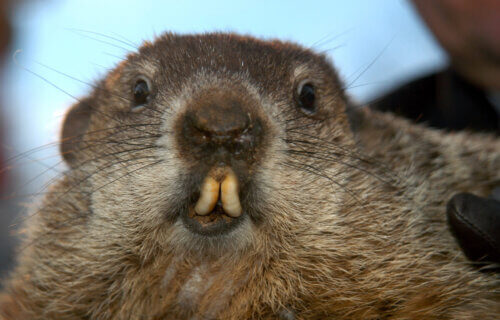PUNXSUTAWNEY, Pa. — Spring lovers can rejoice as the legendary Punxsutawney Phil did not see his shadow on this Groundhog Day, the 138th ceremony of the long-standing American tradition. This means spring will be arriving early in 2024, according to the wise groundhog.
As the ceremony goes, Phil was brought out of his winter sleep by the president of the Punxsutawney Groundhog Club. He was placed on his honorary podium where he then made his decision, read by the president to the excited crowd.
“Hear ye! Hear ye! Now on this February 2, Punxsutawney Phil, the seer of seers, prognosticator of all prognosticators was awakened from his wintry nap at dawn on Gobbler’s Nob,” the president read aloud. “Phil looked to the skies and then, speaking in ‘Groundhogese,’ directed the president to the proper scroll, which reads:
‘Another winter’s slumber paused so I could meet the crowd. It’s hard to sleep anyway when the party’s this loud. I envy your energy, I envy the fun. I envy all of you (and your opposable thumbs). But it’s not what I feel, it’s what I see and what you hear. So gather ’round and let me be clear. Atmosphere is a wonderful thing and we can create our own — and the weather it brings. It brings hope for the future and so much more… maybe some Punxsutawney Phil write-in votes in 2024. But what this weather did not provide is a shadow or reason to hide. Glad tidings on this Groundhog Day, an early spring is on the way!‘”
While it may seem silly to take Phil’s word for it, it turns out the majority of Americans are more likely to trust a rodent than their local meteorologist.
That’s according to a OnePoll survey of 2,000 U.S. adults in 2022, which reveals that 58 percent agree that whether or not Punxsutawney Phil sees his shadow on Groundhog Day actually determines if there will be six more weeks of winter. Moreover, more than one in four Americans “strongly agree” with this statement. Do you?

Groundhog Day & Punxsutawney Phil’s Origins
Nestled in the heart of Pennsylvania, the small town of Punxsutawney has been thrust into the global spotlight each February 2nd, thanks to its most famous and furry resident—Punxsutawney Phil. This groundhog, known for his weather prediction prowess, has become an icon of American folklore and tradition. But how did a simple rodent ascend to such prominence, and what role did Hollywood play in elevating his status?
Groundhog Day finds its roots in ancient European weather lore, where a badger or sacred bear was the original weather forecaster. The tradition was brought to America by German settlers, the Pennsylvania Dutch, who found groundhogs to be plentiful in their new homeland and a suitable substitute for their European counterparts. According to legend, if the groundhog sees its shadow upon emerging from its burrow on February 2nd—due to clear weather—it will retreat back into its den, signifying six more weeks of winter. No shadow suggests an early spring.
The first official Groundhog Day celebration in Punxsutawney was recorded in 1887, where a group of spirited locals, known as the Punxsutawney Groundhog Club, declared Phil as the only true weather-predicting groundhog. The event has since grown from a small gathering to a massive annual festival, attracting thousands of visitors from around the world eager to witness Phil’s prognostication firsthand.
So, as the legend goes, if Phil sees his shadow and gets spooked, there will be six more weeks of winter.
Phil’s Rise to Stardom
Phil’s journey from local curiosity to international celebrity was largely propelled by the 1993 film “Groundhog Day.” Directed by Harold Ramis and starring Bill Murray, the comedy classic follows a weatherman caught in a time loop, endlessly reliving February 2nd in Punxsutawney. While the movie was not filmed in Punxsutawney itself, it brought unprecedented attention to the town and its celebrated groundhog.
The film’s success not only boosted tourism but also made Punxsutawney Phil a household name. His annual predictions started to be broadcast on national television, and the town’s Groundhog Day event became a must-see spectacle. Phil has since been featured in numerous media outlets, further cementing his status as a cultural icon.
Legacy and Controversy
Despite his fame, Punxsutawney Phil’s accuracy rate has been a topic of debate among meteorologists and skeptics. According to the National Oceanic and Atmospheric Administration, Phil’s forecasts have shown no significant predictive skill over the past few decades. According to studies on the groundhog’s accuracy, he’s only right 39 percent of the time – worse than your odds on a coin flip. Nevertheless, Phil’s supporters argue that the event is meant to be taken in good fun and that the true value lies in the tradition and community spirit it fosters.
As Punxsutawney enjoys his celebratory feast for another Groundhog Day, the legend of Phil endures, transcending the realms of folklore, entertainment, and even meteorology. Whether seen as a beloved tradition or a peculiar oddity, Punxsutawney Phil’s legacy is a testament to the enduring appeal of local customs in the age of global culture. As long as there is winter, there will be eager eyes watching Phil, waiting to see what the season holds.
In the words of Phil Connors (Bill Murray) from the beloved film: “When Chekhov saw the long winter, he saw a winter bleak and dark and bereft of hope. Yet we know that winter is just another step in the cycle of life. But standing here among the people of Punxsutawney and basking in the warmth of their hearths and hearts, I couldn’t imagine a better fate than a long and lustrous winter.”

